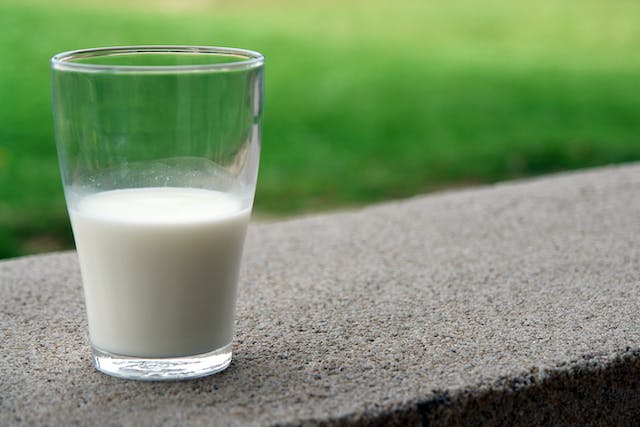
Why are some people lactose intolerant? Because their body doesn’t make enough of an enzyme called lactase.
Milk is a liquid produced in the mammary glands of most mammals. It is made of 87% water with the remainder made up mostly of fat, protein, carbohydrates, vitamins, and minerals. The proteins act as an emulsifier because they help the fats to mix into the water, making the milk white. If you leave milk to stand after it has been taken from a cow, the fatty part will rise to the top. These proteins are called caseins. Milk is produced to nurture animals that have just been born until they have grown and can feed themselves. For this reason, it contains a lot of energy in the form of carbohydrates, fats, and proteins, along with vitamins and other nutrients.
The main carbohydrate in milk is called lactose. Lactose is a disaccharide, which means it is made of linked single molecules of sugar. There are many different types of sugar and lactose is made of a chain of glucose and galactose. Glucose is the most common sugar that we eat. Galactose is very similar to glucose, but it is a less stable molecule. When baby mammals drink milk, they need to get at these sugars and all of the other nutrients in the milk. To break down the lactose into its component sugars so they can be absorbed, all mammals need an enzyme called lactase. Lactase is produced in the lining of the small intestine and it can break the bonds holding the galactose to the glucose, enabling them to be absorbed into the intestine and then into the blood.
All mammals that drink milk as babies produce lactase as their only source of food is the milk. However, once they are old enough, they stop drinking milk and start eating the same food as their parents. At this point, they naturally stop producing lactase in a process called weaning. After this, they can no longer drink milk and they do not. Humans, on the other hand, do continue to drink milk, leading to problems for a large portion of the population that are lactose intolerant.
Humans also drink milk when they are born and it is their only source of food. They don’t have teeth and milk is all that they can take in. Their throats are specially adapted so they can breathe while they are drinking. This adaptation disappears after they are weaned and they stop drinking milk. For many people, the same as with all other mammals, their intestines stop producing the enzyme lactase as well. This produces the problems associated with lactose intolerance because we use a lot of milk and milk products in our daily lives. We have yoghurts, cheeses, ice creams and so many other milk-based products. When someone who’s body doesn’t produce lactase drinks milk, the lactose is not broken down in the small intestine and it travels on to the long intestine. There, bacteria break down the sugars into acids and gases, fermenting it. This leads to the stomach pain and the other problems lactose intolerant people have. Diarrhea is common as well because the lactose that hasn’t been eaten by the bacteria absorbs water, meaning water stays in the digestive tract, which causes diarrhea.
That’s why many people are lactose intolerant. The question should be, why are so many people not lactose intolerant? It turns out that the majority, probably 65%, of the world’s people are lactose intolerant. The people that still produce lactase after they are weaned and can digest milk have a genetic mutation. The majority of these people are in European countries and some parts of Africa. The theory is that about 8,000 years ago, people started to spread out from the Fertile Crescent and settle in areas around modern Turkey. They took the crops they had been growing before, wheat and barley, which didn’t grow as well in the climates of the new areas they were living in. That meant famine. At the same time, people had started to domesticate cows and realized they could drink cow milk. The theory is that people who didn’t possess the gene that allowed them to keep producing lactase developed diarrhea and died, while the people who did possess the gene were able to drink milk and survive the famine. The more famines there were, the more likely this gene would be to be passed on, which is why the majority of people that came from the region can drink milk with no problem and a large number of people who didn’t come from this area can’t. And that is what I learned today.
Photo by Pixabay: https://www.pexels.com/photo/blur-calcium-close-up-dairy-236010/
Sources
https://foodinsight.org/what-is-lactose/
https://www.nhs.uk/conditions/lactose-intolerance/
https://www.hopkinsmedicine.org/health/conditions-and-diseases/lactose-intolerance
https://en.wikipedia.org/wiki/Milk
https://www.hsph.harvard.edu/nutritionsource/milk
https://www.dairy.com.au/dairy-matters/you-ask-we-answer/why-is-milk-white
https://en.wikipedia.org/wiki/Galactose
https://www.betterhealth.vic.gov.au/health/conditionsandtreatments/lactose-intolerance
